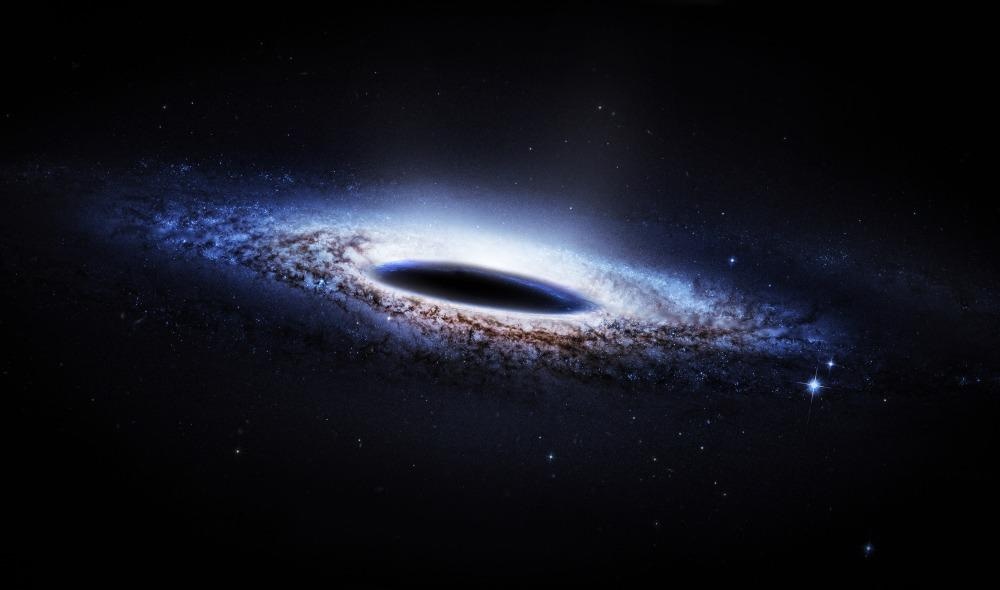An international collaboration of astrophysicists from South Africa, the United Kingdom, the United States, and France have discovered large disparities in the brightness of light seen from around one of the nearest black holes in the galaxy, 9,600 light-years from the Earth, which they state is the result of a massive warp in its accretion disk.

Image Credit: Dima Zel/Shutterstock.com
In March 2018, this object, MAXI J1820+070, erupted as a new x-ray transient and was detected by a Japanese x-ray telescope onboard the International Space Station. These transients, systems that display intense outbursts, are binary stars containing a low-mass star, akin to the Sun, and are a lot more compact, which can be a neutron star, white dwarf, or black hole.
Here, MAXI J1820+070 comprises a black hole that is no less than 8 times the mass of the Sun.
The principal findings have currently been accepted for publication in the internationally renowned journal, Monthly Notices of the Royal Astronomical Society. The study’s lead author is Dr Jessymol Thomas, a Postdoctoral Research Fellow at the South African Astronomical Observatory (SAAO).
The discovery illustrated in the article was made from a wide-ranging and detailed light-curve acquired over nearly a year by committed amateurs worldwide who are part of the American Association of Variable Star Observers (AAVSO).
MAXI J1820+070 is one of the three brightest x-ray transients ever detected, a consequence of both its nearness to Earth and being outside of the obscuring plane of the Milky Way Galaxy. Since it stayed bright for a number of months, many amateurs were able to follow it.
Material from the normal star is pulled by the compact object into its surrounding accretion disk of spiraling gas. Massive outbursts occur when the material in the disk becomes hot and unstable, accretes onto the black hole, and releases copious amounts of energy before traversing the event horizon. This process is chaotic and highly variable, varying on timescales from milliseconds to months.
Phil Charles, Research Team Member and Professor, University of Southampton
The researchers have created a visualization of the system, presenting how an enormous x-ray output originates from very close to the black hole, and then irradiates the nearby matter, specifically the accretion disk, heating it up to a temperature of about 10,000 K, which is observed as the visual light emitted. Therefore, as the x-ray outburst diminishes, so does the optical light.
However, something unanticipated occurred nearly 3 months after the outburst activated when the optical light curve began a massive modulation—a bit like switching a dimmer switch on and off and nearly amplifying in brightness at its peak—during a period of around 17 h.
However, there was no variation at all in the x-ray output, which stayed steady. While small, quasi-periodic visible modulations had been witnessed in the past during other x-ray transient outbursts, nothing of this magnitude had ever been witnessed in the past.
What was triggering this unusual behavior?
With the angle of view of the system as shown in the pictorial, we could quite quickly rule out the usual explanation that the X-rays were illuminating the inner face of the donor star because the brightening was occurring at the wrong time.
Phil Charles, Research Team Member and Professor, University of Southampton
Nor could it be because of variable light from where the mass transfer stream reaches the disk as the modulation progressively moved relative to the orbit.
This left only one likely justification, that the massive x-ray flux was irradiating the disk and making it warp. The warp offers an enormous increase in the area of the disk that could be irradiated, thereby making the visual light output grow significantly when seen at the correct time.
Such behavior had been observed in x-ray binaries with more enormous donors, but never in a black-hole transient possessing a low mass donor like this. It opens a totally new path for exploring the structure and properties of warped accretion disks.
This object has remarkable properties amongst an already interesting group of objects that have much to teach us about the end-points of stellar evolution and the formation of compact objects. We already know of a couple of dozen black hole binary systems in our Galaxy, which all have masses in the 5 – 15 solar mass range. They all grow by the accretion of matter that we have witnessed so spectacularly here.
Phil Charles, Research Team Member and Professor, University of Southampton
Beginning some 5 years ago, a key science program on the Southern African Large Telescope (SALT) to explore transient objects has made several crucial observations of compact binaries, including black hole systems such as MAXI J1820+070.
As the principal investigator for this study, Prof. Buckley, explains “SALT is a perfect tool to study the changing behavior of these X-ray binaries during their outbursts, which it can monitor regularly over periods of weeks to months and can be coordinated with observations from other telescopes, including space-based ones.”
Journal Reference:
Thomas, J.K., et al. (2021) Large optical modulations during the 2018 eruption of MAXI J1820+070 reveal the evolution of warped accretion disk by X-ray state change. Monthly Notices of the Royal Astronomical Society.